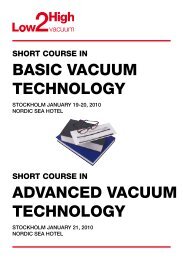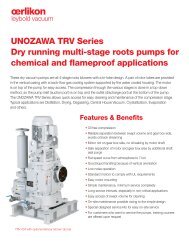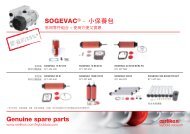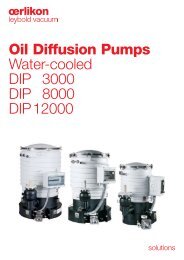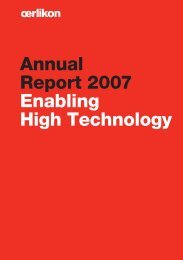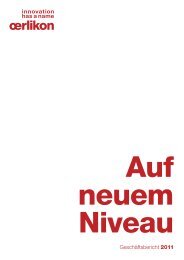Annual Report 2011 (5.07 MB, PDF-File) - Oerlikon
Annual Report 2011 (5.07 MB, PDF-File) - Oerlikon
Annual Report 2011 (5.07 MB, PDF-File) - Oerlikon
Create successful ePaper yourself
Turn your PDF publications into a flip-book with our unique Google optimized e-Paper software.
48<br />
When a fine spray of fuel is fired into the engine’s combustion<br />
chamber under 2 000 bars of pressure, there is tremendous<br />
stress on injection nozzles, valves, piston rings, etc. Without<br />
the high-strength carbon coating developed for this application,<br />
the components would quickly become damaged and fail.<br />
<strong>Oerlikon</strong>’s technologies account for up to 4 % of the fuel savings<br />
achieved by state-of-the-art engines today. High-performance<br />
coatings not only help achieve better fuel economy, but<br />
also significantly lower emissions: the high injection pressure,<br />
combined with higher fuel concentration, allow more complete<br />
combustion. The higher the combustion level, the lower the engine’s<br />
emissions. Since the introduction of high-pressure injection,<br />
carbon dioxide and nitric oxide emissions from diesel engines<br />
have plunged by some 30 %.<br />
Another technology that plays a major role in environmental<br />
protection is LEDs (light-emitting diodes). <strong>Oerlikon</strong>’s Advanced<br />
Technologies Segment produces machinery that enables critical<br />
process steps in LED production: application of a mirrored<br />
and barrier layer, and the establishment of electrical contact.<br />
The energy-conservation potential with high-brightness LEDs is<br />
enormous. Compared to incandescent bulbs, LEDs such as<br />
those fitted throughout <strong>Oerlikon</strong> Advanced Technologies’ facilities<br />
have five to ten times more light output (50 lumens/Watt<br />
compared with 5 – 10 lumens/Watt). This means they consume<br />
just 10 % to 20 % of the energy required by filament bulbs to<br />
produce the same amount of light. LEDs are the most energyefficient<br />
light source currently available and therefore economically<br />
and environmentally friendly: less cost, less CO2. In Switzerland,<br />
for example, about 14 % of all generated electricity is<br />
used for lighting households, offices, industrial spaces, etc.<br />
Considering that lighting accounts for 50 % of the average<br />
commercial electricity bill, the cost savings made possible by<br />
switching to LED lighting is tremendous. The Swiss Energy<br />
Foundation has determined that households alone have a savings<br />
potential of 60 %.<br />
<strong>Oerlikon</strong> Solar has become the technology and cost leader of<br />
assembly lines that make thin film solar modules. Because the<br />
viability of solar power generation depends largely on cost<br />
Letter Information for Investors Operational Review Sustainability Compliance Corporate Governance<br />
– measured in Euros or US dollars per Watt-peak (Wp) – <strong>Oerlikon</strong><br />
Solar focuses continually on lowering the manufacturing costs<br />
of solar modules and further increasing their capacity, which<br />
makes clean energy more economically attractive. The new,<br />
fully integrated second generation ThinFab TM line allows customers<br />
to produce the highest-quality thin film silicon modules<br />
at costs of around USD 0.5/Wp – a new record in the industry.<br />
The production of <strong>Oerlikon</strong> thin film silicon modules requires<br />
less energy than all other the solar manufacturing processes<br />
and the “energy payback time” of <strong>Oerlikon</strong> technology is less<br />
than a year – these are unique benefits. Furthermore, <strong>Oerlikon</strong><br />
Solar modules are manufactured in an environmentally friendly<br />
manner without the use of toxic substances such as<br />
cadmium.<br />
HSE: a company-wide system being developed<br />
In terms of health, safety and environment requirements (HSE),<br />
<strong>Oerlikon</strong> complies with local laws and regulations in force at<br />
each of its production sites. These generally vary from location<br />
to location and Segment to Segment. Related certificates<br />
(OSHA, ISO) are obtained and updated solely on a decentralized<br />
basis. A uniform, company-wide reporting, collection and<br />
management unit is currently being assembled at <strong>Oerlikon</strong>’s<br />
headquarters. The aim of this effort is to improve HSE transparency,<br />
facilitate comparability across the Group and to ensure<br />
uniform standards. These standards will be designed to help all<br />
locations throughout the Group attain the world-class standards<br />
achieved by <strong>Oerlikon</strong>’s state-of-the-art production units.<br />
The company is striving to create a culture in which all occupational<br />
accidents and illnesses, all environmentally relevant deviations<br />
and all pollution are avoided. <strong>Oerlikon</strong> will drive the HSE<br />
agenda from headquarters using additional personnel, uniform<br />
company-wide guidelines, audits, a reporting system and incorporation<br />
of targets into the company’s 3-Year Business<br />
Plan. As a result of this work, HSE will become an integral part<br />
of the company’s Operational Excellence efforts.<br />
HSE steps being taken at all production sites include the recycling<br />
of production waste, particularly leftover metal, as well as<br />
packaging material, liquids and wood. Some of the company’s




